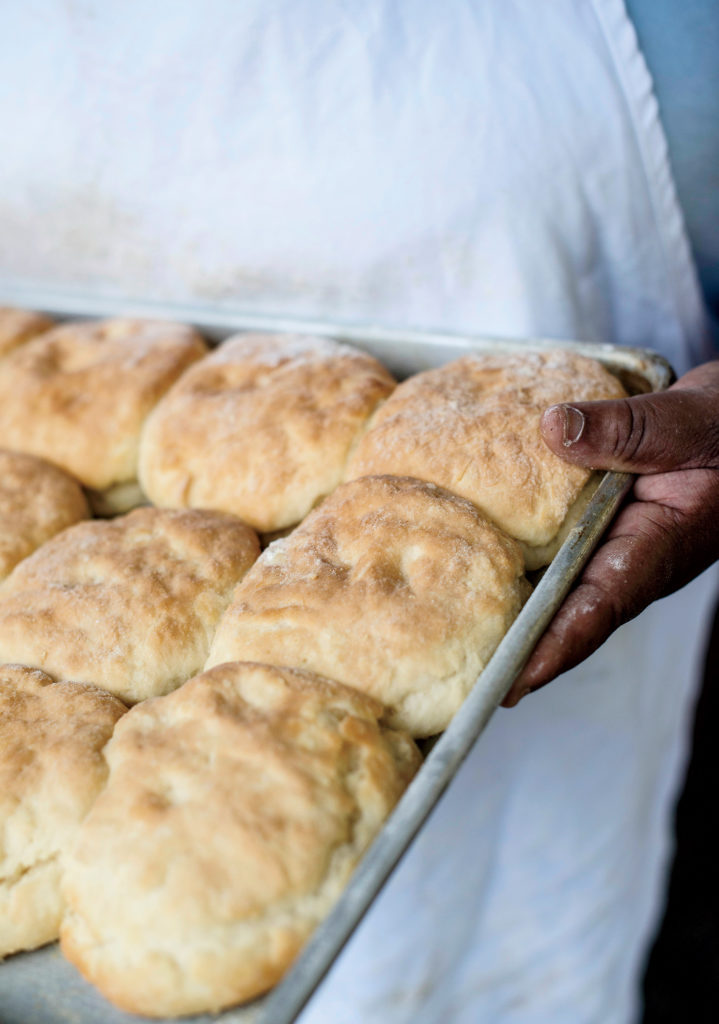Food & Drink
The Comfort of Southern Food
The value of the table in the digital age

Photo: Photo-illustration Darren Braun
The other day I was avoiding work by wandering around on the Internet when I came across a photograph of President Obama and German chancellor Angela Merkel. They were studying romaine lettuce growing in the White House kitchen garden. Merkel seemed to be gesturing meaningfully toward some herbs. Obama, his jacket slung over his shoulder like he had just gotten home from work, looked as if the garden mattered as much as the Russian troops bearing down on Ukraine. A decade ago, the White House spin machine would never have thought it important to release that photograph. But these days, a vegetable is much more than just a vegetable.
As the golden age of jazz defined the fast-moving 1920s or film helped us unpack the harsh realities of war and changing sexual mores in the 1970s, food has become the cultural currency of our time. In a world of GIFs and hashtags, where technological upheaval is a fact of daily life, food has become the primary refuge for those seeking the tangible. And Southern food, above anything else we are eating in this country, is the most precious haven of all. Deeply rooted in both the land and the people who have worked it, it is the original farm-to-table cooking—America’s first and truest cuisine. More than a six-dollar heirloom tomato, it is beans and rice and greens. It is pork for flavor, not bacon for effect.
But anyone who has sat back and watched the meteoric rise of what people like to call the New Southern Cuisine knows there is also something bigger at work. Chefs in Los Angeles didn’t just wake up one day and think that serving grits seemed like a great idea. Antebellum oats didn’t just magically appear on an expensive menu in Manhattan. There’s some history here, a foundation built on the changing nature of chefs and a shift in our approach to food in general.
All across the country, chefs have moved beyond the rock-star phase of the 1980s. Their opinions on gun laws, immigration reform, gay rights, and poverty are offered up and hungrily received by people who first found them because they were good cooks. And food is now the “it” realm for famous people from other cultural neighborhoods. Actors are writing cookbooks. Politicians brag about their cooking skills. Bay Area venture capitalists are opening grass-fed burger chains. At the James Beard Awards this year, where chefs and wine stewards waited to see who would get their food Oscars, Trisha Yearwood handed out awards, Kings of Leon sang, and everyone took a selfie with Questlove.
How we eat has become our cultural organizer. Fast food used to be a novelty, then a necessity. Now it’s a symbol of class division. Homemade sausage used to be the stuff of a peasant class. Now it is the new luxury food. A country ham and the person who smoked it are as revered as an haute couture dress and the woman who designed it.
Farmers’ markets have gone from being a precious playground of the California elite to weekly fixtures of the town square. The farmers’ markets of North Carolina’s Triangle region are bona fide tourist destinations. The U.S. Department of Agriculture puts the official count at 8,144 nationwide—up an astounding 350 percent in twenty years—but that doesn’t necessarily include all of them. Southern Baptists host farmers’ markets in their church parking lots.
Movies, concerts, and relationships can all be had with a keyboard and a screen. Anyone can become a star by posting the right video on YouTube. But you can’t eat through the computer. Thus, farmers’ markets and restaurants are some of the last places to physically gather around the tribal fire at a time when that fire is increasingly digital.

Photo: Lissa Gotwals
Flour Power
Fresh-baked buttermilk biscuits, a taste of home.
Southern food has been an important player in all of this. You can trace the roots of the Southern food renaissance to 9/11, when a stunned nation went looking for comfort. They saw the cakes and homey meat-and-threes of the South as the balm, the region’s adherence to culinary tradition and its agrarian-driven table as the softest and most delicious place to land.
It is no coincidence that Paula Deen finally got the Food Network contract she’d been chasing for years in the months after the attacks. It took the growing pain of globalization and terrorism, and the exhaustion inherent in the technological revolution, to see that solace had been here in the South all along.
People who were ready to look beyond the pone of Paula and the clichéd umbrella of soul food found a culinary landscape that was far more complex and complicated. Southern food is hundreds of micro-cuisines, from the rice, grits, and shrimp of the Lowcountry to the chocolate gravy of the Ozarks to the trout amandine of New Orleans. We are the Italy of America.
The table is the place Southerners turned to work out our own political and cultural strife long before food became the nation’s cultural currency. After all, barbecue and peach pie and butter beans are more than just shared dishes; they’re also the things that bind us together.
And there is no app for that.







